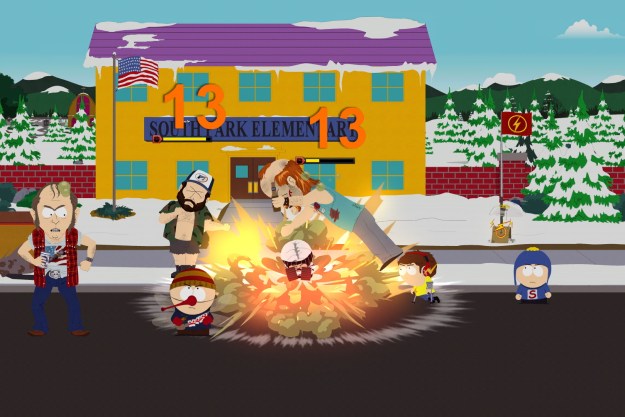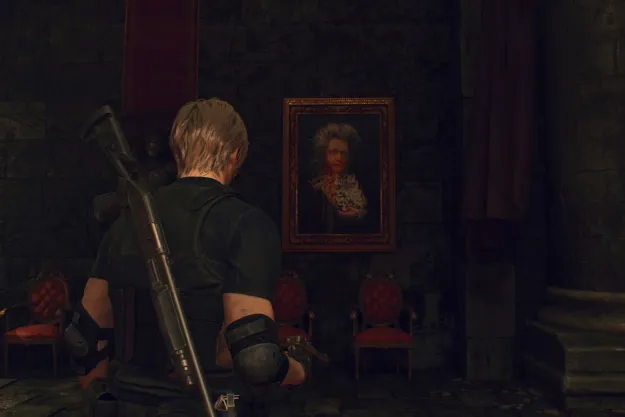
““South Park: The Fractured But Whole” struggles to capture what’s made the show endure for 20 years.”
- Story really comes together toward the end
- Lots of variety in superheroes adds strategy
- You won’t be convinced if you’re not already a fan
- Lots of tired, obvious joke
- Plot takes a while to get going
- Some of the show’s best characters go underused
There’s something that feels off about South Park: The Fractured But Whole. For a game that’s based on a show that has fought controversy and worked to be both sharp and crass for its entire two-decade run, maybe it’s just hard to ring more humor out of the old concepts. Maybe audiences have been shocked so many times before, shocking them again is too tough. Maybe the tank is running on empty.
Fractured but Whole, the sequel to South Park: The Stick of Truth just doesn’t quite reach the humorous heights of the best moments of the show or the previous game, which drummed out of the novelty of turning out an extended South Park episode in video game form. While The Stick of Truth had its own issues, it set a pretty high bar in terms of being both a fan service-drenched love letter and a funny, standalone story. It even managed to shock longtime fans with over-the-top moments — like fighting a giant fetus in an abortion clinic. For a show and a video game about shocking audiences and saying what others might shy away from, it’s kind of tougher to find another plateau.
While The Fractured But Whole improves on video game aspects of its predecessor — combat is deeper and more fun, there’s more strategy to gameplay and more to find and explore in South Park — it struggles with the parts that define South Park. More than anything, much of the game struggles to generate laughs.
Go play outside
The Fractured But Whole picks up basically immediately after The Stick of Truth, with players reprising the role of the silent New Kid who played hero in the first game. Early on, the kids transition from playing that game’s Lord of the Rings-like fantasy to a superhero one. Like its predecessor, The Fractured But Whole is an extended riff on a conceit established on the show, but features a narrative written by South Park creators Trey Parker and Matt Stone specifically for the game. That said, all the gags and back story from South Park’s skewering of superhero movie franchises are pretty much required viewing to understand some of the subtler story points. And, like The Stick of Truth, trying to keep up with The Fractured But Whole without being a longtime fan of South Park is probably a wasted effort, although the barrier of entry is lower than before.
The narrative is mostly the focus throughout, but it’s augmented by a pretty decent tactical role-playing game. As with The Stick of Truth, combat is mostly turn-based, with each character coming in with a host of “superpowers.” Combat is more tactical this time, taking place on a grid that adds an element of strategic positioning to your decisions. Where characters stand (and how far they can move in a turn) determines who they can attack, and who can hit them back.
You fight alongside a rotating posse of other superheroes from the South Park kids’ two major franchises: Coon and Friends and Freedom Pals. The split between the two groups has created a Captain America: Civil War-esque feud that’s the underlying conflict for much of the plot. Meanwhile, there’s a real crime wave in town and the kids are trying to get to the bottom of who’s behind it all.
Much of the game struggles to generate laughs.
When you aren’t fighting, you’ll spend a lot of time wandering around town completing side missions for other characters, solving puzzles using your fart-fueled abilities (the New Kid’s farts are, in fact, a superpower unto themselves). Some of these, like helping Kyle get rid of his annoying cousin or fighting ninja assassins, are fun asides. Others, like fetching all of Big Gay Al’s missing cats, are not. Much of the formula from The Stick of Truth remains unchanged, and the game will often funnel you into these side quests to earn experience and raise your “might level” between more challenging main story missions.
There’s more of an emphasis on RPG elements like crafting and upgrading your character, which go hand-in-hand. You’ll pick up materials for crafting all over that can be used to make healing items and “artifacts” that upgrade your stats, which adds a bit of strategic planning on upgrading your character and maximizing your stats to match your chosen superhero classes.
Those systems, however, are pretty lightweight. You only need to invest as much time and brainpower as you feel like. You can’t skip them entirely, you can come pretty close. Of course, that makes sense, because the real reason South Park fans pick up the game is for its story and its humor. On that front, though, The Fractured But Whole is often a bit of a mess.
Confused comedy
The Stick of Truth wowed audiences because looked and felt like a playable episode of South Park, complete with all the characters, weirdness and off-color jokes that that entails. While It was generally well liked and pretty funny, The Stick of Truth was also effectively a South Park greatest hits tour, and spent most of its time referencing and rehashing old jokes from the show’s two-decade run than doing its own thing. After so much fan service in the last game, The Fractured But Whole has been set free to strike out in search of new jokes.
Historically, South Park’s humor has fallen into one of two categories: Outwardly absurd, and the topically satirical. In recent years, the show has become best-known for takes on current events, but it’s usually funniest when it’s gets outlandish, like when it did a three-part epic out of nowhere about an imaginary place where just about every fictional character ever created lives, years before The Lego Movie turned that concept into a box office win.

South Park: The Fractured But Whole spends a lot of its time mining fairly topical issues for humor, but rarely seems to know exactly what joke it’s trying to make. The biggest example of this is in how the game treats character decisions like gender and race. Part of advancing through The Fractured But Whole is filling in your “character sheet,” in which players define the New Kid through several different quests. The game puts a ton of emphasis on these moments. When you head to the elementary school to talk to Mr. Mackey about your sex, for instance, it takes two tries — you identify your character’s biological sex, define their gender, and their sexuality. That’s done with a series of menus filled with a big hodgepodge of real terms the game doesn’t bother to explain. When you’ve picked your gender and sexuality (which you can change whenever you want), you wander outside, only to be attacked by a group of stereotypical rednecks who hate you for your identity, regardless of your choice.
The Fractured but Whole repeats this process again and again with gender, race, and even religion, but the joke it’s trying to land is confused. Is the point that we place too much emphasis on identity labels? That gender and sexuality are choices, and what’s more, easy and fluid ones? That inclusivity is a waste of time? Or is it that this is a video game and nothing matters anyway? In the end, it doesn’t really matter: None of those reads are especially new, nuanced — or funny. There are a few moments like this, when the focal point of the joke is blurry and its purpose unclear, and they weaken the entire experience.
That’s not to say all of The Fractured but Whole’s attempts at topical or relevant humor are a bust. A lengthy, plot-related riff on Black Lives Matter, police brutality, and racism actually lands pretty well once the game really leans into it. It makes a clear, salient satirical point, and the more ridiculous it becomes, the funnier and more poignant it gets (although it still does little in the way of saying anything that hasn’t been said before).
In the last few hours, the game lets go of the reins entirely, embracing some of its most absurd ideas. In a few great callbacks to Season 1 material, the game manages to make referential jokes that are funny in their own right. Throughout the experience, the further off the rails things get in The Fractured But Whole, the funnier and more fun they become. The second half of the game is substantially more fun than the first, if you have the time and will to get there.
Our Take
South Park: The Fractured But Whole isn’t an even experience. Some moments are fun and pretty funny, but others feel pretty uninspired. Exploring the town of South Park isn’t as novel this time out, and it largely isn’t as funny. RPG systems like combat, looting and crafting are just involved enough to make them interesting, but the firm emphasis is on the story and humor of the show. With the plot taking a while to develop and with so many jokes just feeling played out, loose on their landings or easy and obvious, it’s tough to really get excited to head back down to South Park.
Is there a better alternative?
RPG fans can find deeper gaming experiences just about anywhere, with the recently released Divinity: Original Sin 2 coming to mind. But for South Park fans, the better option might just be this game’s predecessor, South Park: The Stick of Truth.
How long will it last?
Our review playthrough lasted just under 20 hours and included completing almost all the game’s sidequests. There’s also a season pass for downloadable content that can extend the experience, but there’s quite a bit of South Park content in the game to start with.
Should you buy it?
For South Park fans and players desperate for a Stick of Truth sequel, this is a foregone conclusion. If you aren’t a die-hard fan of the show and the game, though, The Fractured But Whole is not the best way to dip back into South Park.
This game was reviewed on Playstation 4 using a copy provided by the publisher.
Editors' Recommendations
- The best cozy games
- Where to find planes in Fortnite OG
- South Park is getting a new game next year, and it’s a 3D action game
- Fortnite Artifact Axe: how to destroy stones and best location
- This trick guarantees you’ll get bots only in every Fortnite match






